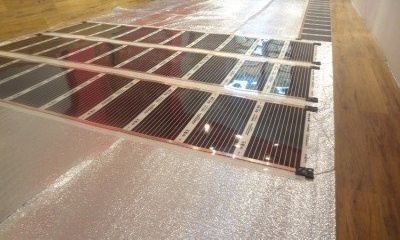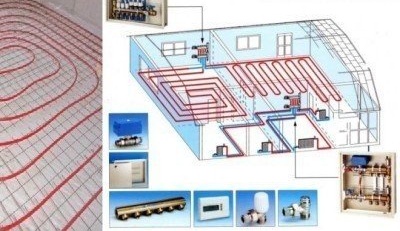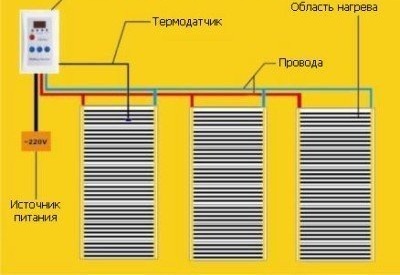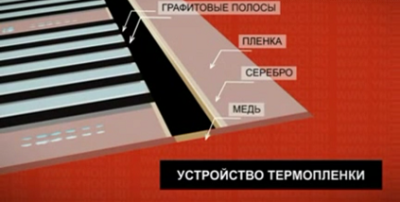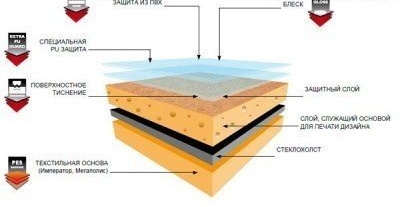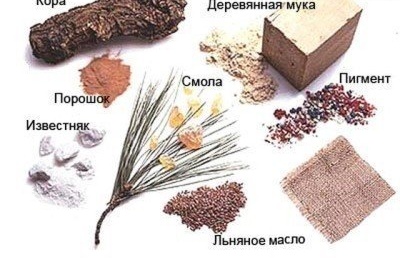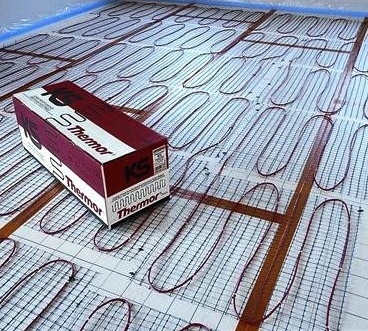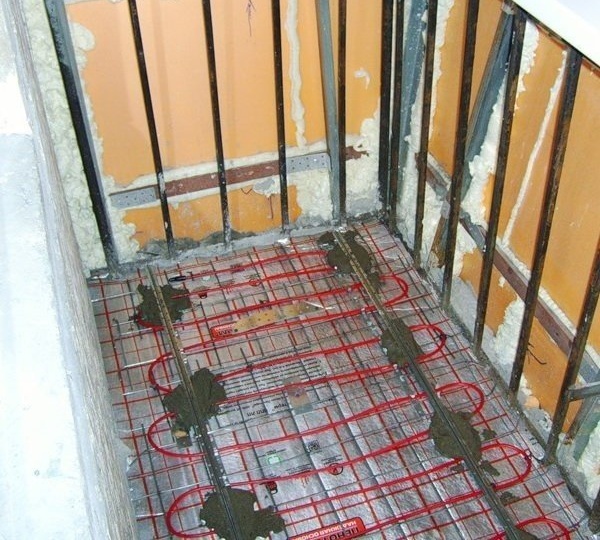Underfloor heating under linoleum - comparison of water and infrared options + installation technology
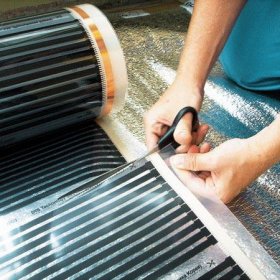
It’s not in vain that folk wisdom says: “Keep your head in the cold, and your feet warm”, because the feet are concentrated a lot of nerve endings, which are a kind of projection of all the internal organs of man. If the legs are warm, then the whole body is comfortable. That is why, striving for a harmonious sensation of their body, since prehistoric times, people have tried to warm the floors of their homes. Having overcome the long way from primitive underground channels to infrared heating elements, the “warm floor” system has firmly established itself in modern homes. Parquet or carpet, laminate or linoleum - warm floors can be laid under any floor covering, having previously figured out which heating system will be most optimal for each particular case.
Content
Which option do you prefer - water or infrared?
At the moment, there are two principles for arranging warm floors - electric and water.
When heating the premises with an electric underfloor heating, alternating current flowing in the mains acts as a heat carrier. Entering a heating cable or film, the electric current is transformed into heat.
On our site there are several articles about the “warm floor” system, one of them provides a comparison of several options, their pros and cons:https://aquatech.tomathouse.com/en/otoplenie/teplyj-pol/kakoj-teplyj-pol-vybrat.html.
In the water floor heating system, the hot water is the central heating, which circulates through pipes mounted in the thickness of the screed. The heat from the pipes or film heats the surface layer of the floor, thus spreading throughout the room. Let's look at the advantages and disadvantages of an electric and water heating system in order to understand what kind of underfloor heating under linoleum will be the key to comfort and ease of use.
It is interesting to know: The oldest floor heating system - ondol, existed in Korea from the 1st century BC. e. The heat emanating from the furnace was distributed through the channels laid in the underground space.
Comparing heating systems, it should be noted that a water heated floor is more often used in individual construction, and electric - in the arrangement of apartments. In apartment buildings, a water heating system is used less often, since the central heating system, especially in old houses, is not designed to increase the load. Therefore, the insertion of a warm floor into the heating pipe can end, simply put, in trouble. Hot water circulating through the pipes of the water floor, gradually cools and returns to the riser almost cold. This means that in an apartment located a floor below, heating radiators will not heat up.
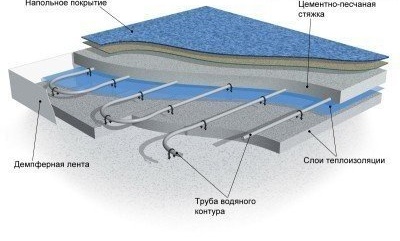
Water floor heating is laid in the thickness of the screed, evenly heating the surface of the floor covering
Otherwise, the situation is in new houses, where, as a rule, the heating system is put on the floor and branches in a screed. In this case, the water floor under the linoleum can be mounted without much difficulty. It is enough to disassemble the screed and embed the contour of the underfloor heating pipes into the existing wiring. However, having “made friends” with the heating system, a water heated floor may run into a new obstacle - the ceiling height. When installing water heating, the loss in height of the room will be 100-150 mm due to the “pie” of the warm floor, consisting of insulation, fittings, pipes and an additional layer of screed. A similar disadvantage is deprived of an infrared warm floor, which is a thin film that minimally affects the height of the room.
Another fundamental property of warm floors is inertia. Water floor heating has a high inertia, that is, it slowly heats up and cools for a long time. Such gradual heating is well combined with linoleum, protecting the floor from overheating due to sudden temperature jumps. Film underfloor heating under linoleum in this regard is not as good as water. The low inertia of infrared heating elements, on the one hand, allows you to quickly adjust the temperature mode of heating, but on the other hand, it can lead to overheating of linoleum.
Regarding the effect on human health, water floor heating is more useful. An electric film floor is not as safe as it might seem. It generates weak electromagnetic radiation, like any other electrical device. Moreover, static electricity will accumulate on the surface of the infrared heat-insulated floor, which means that the floor covering will attract dust particles intensively.
When choosing a warm floor system, it is necessary to evaluate its efficiency in two aspects - in installation and in operation. Water floor heating will require significant financial investments at the installation stage, but will be more economical to use. Infrared underfloor heating under linoleum, on the contrary, is simple and inexpensive to install, but will turn out to be a considerable energy consumption during the operation phase. Having appreciated all the pros, cons of the water and infrared warm floors, you just have to choose a heating system that is optimally suited to the specific conditions of your house or apartment - linoleum is perfectly combined with any of them.
It is important to know: Among the many decorative floor coverings, linoleum stands out for its cost-effectiveness and ease of installation.
In our next article, detailed instructions for installing an infrared warm floor with your own hands are given:https://aquatech.tomathouse.com/en/otoplenie/teplyj-pol/infrakrasnyj-plenochnyj-teplyj-pol.html
Features of the selection of linoleum for underfloor heating
After the heating system is selected, it is important to purchase the "right" linoleum for laying on a warm floor.
Layered decorative material, linoleum is of artificial or natural origin.
Natural linoleum, although it has a relatively high cost, but at the peak of the popularity of environmentally friendly housing, enjoys steady success. The properties of the natural components that make up natural linoleum suggest that this material is durable, waterproof, non-toxic, non-combustible, does not accumulate static electricity, etc. Laying underfloor heating under natural linoleum is the most appropriate solution to avoid unpleasant odors and toxic fumes arising from heating coatings with synthetic additives.
It is interesting to know: The first natural linoleum from jute soaked in vegetable oils of flax and sunflower was released in 1864 by the English company Walton, Taylor.
However, it cannot be argued that a combination of underfloor heating and linoleum made from such artificial components as polyvinyl chloride (PVC), polyester, nitrocellulose, alkyd resins, etc. is unacceptable. When operating underfloor heating laid under synthetic linoleum, it is necessary to carefully monitor the floor heating mode, maintaining the temperature within 24 degrees Celsius. Unpleasant consequences arising from overheating of artificial linoleum can be: the release of toxic phenol vapor, warping of the surface or discoloration of the coating.
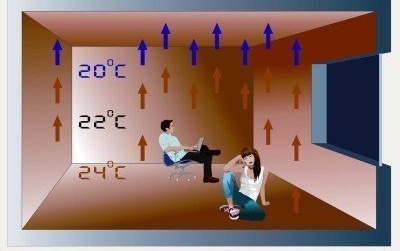
Unlike radiator heating, a warm floor evenly heats the air in the room, creating comfortable conditions
It is important to know: Linoleum insulated with synthetic pile is better not to use for laying on a warm floor. If you plan to use a laminate as a floor covering, then you will be interested in our next article: https://aquatech.tomathouse.com/en/otoplenie/teplyj-pol/teplyj-pol-pod-laminat.html.
Installation method of a water floor heating
Arrangement of a water heated floor should begin with cleaning and preparing the surface of the rough screed. It is important that the screed is “in level” - without significant differences in height. Aligning, if necessary, the base surface of the floor, you can proceed with the installation of a heat-insulating layer that prevents heat loss. As an insulating coating under a water heated floor, polystyrene plates or polystyrene are most often used. At the end of installation, the insulating layer is covered with plastic wrap, damping strips are installed around the perimeter of the room, after which the reinforcing mesh is mounted. Then, pipes of the warm floor are laid on the grid, which are fixed on the armature with the help of clamps. The next important stage of floor installation is to check its tightness under working pressure. If the tests were successful, the water is left in the system and proceed to the final stages of the arrangement of the warm floor - pour the final screed and lay the linoleum.
Laying infrared option
The initial stage of installing an infrared warm floor is to clean and level the surface of the rough screed, after which a heat-reflecting film is laid.
On top of the insulating layer, infrared film strips are installed and fixed with tape. At the next stage of floor installation, a thermostat is installed, from which wires are drawn to each heating strip of the infrared film and connected to the copper connector using special clips. Then, the heating mats are covered with plastic wrap and sheets of plywood, chipboard or OSB are placed on which linoleum is laid.
After laying the plywood or OSB boards, the surface of the floor must be treated with a surface grinder to smooth out possible irregularities that occurred when joining sheets of material.
